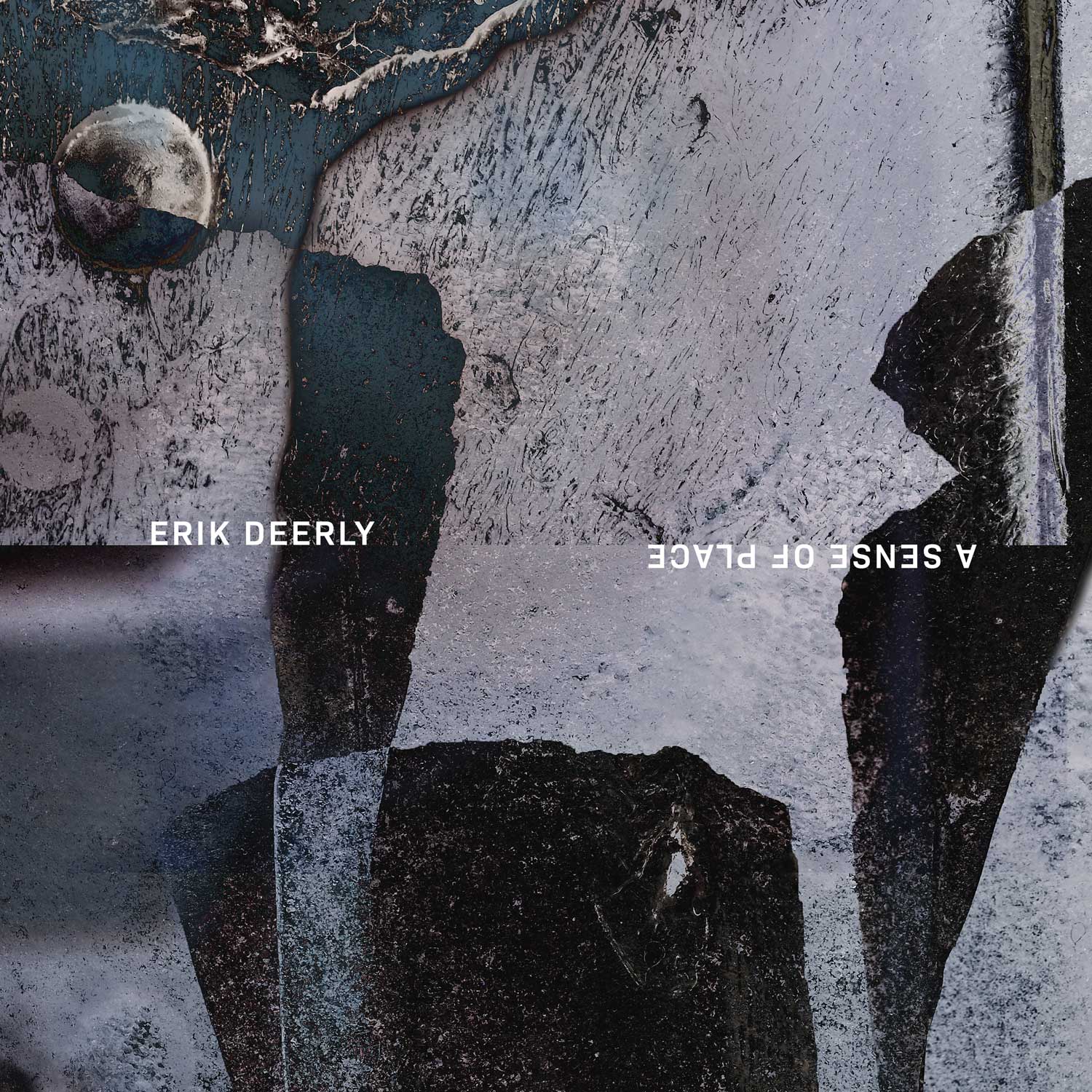A Sense of Place
- Buoyant Erik Deerly 6:09
- Entropy Erik Deerly 6:27
- In the Void Erik Deerly 5:07
- Via Shortwave Erik Deerly 7:30
- A Sense of Place Erik Deerly 6:59
- Tomorrowland Erik Deerly 3:24
- Slipstream Erik Deerly 5:14
- Earth Dance Erik Deerly 10:18
Distributed via your favorite music service.
Arpaviva Recordings, 2022.
Credits
Recorded and produced by Erik Deerly
Executive Producer: Peter Vukmirovic Stevens
Mastering by Carl Saff at Saff Mastering
Album Art and design by Sean Waple
Photography by Isaac Beachy

Liner Notes
The synesthetic perspective is one which naturally encourages the human mind to find the unity beneath seemingly irreconcilable sensory phenomena. Loud and soft, dark and bright, rough and smooth, bitter and sweet — all of these pairs demarcate separate phenomenological fields which nonetheless share a similar power to convey fundamental shapes of experience through time and memory. For American composer and interdisciplinary artist Erik Deerly, the quest for pure “experience” has formed the cornerstone of a lifetime of creativity and research. Born with a condition of chromesthesia (the experience of sounds as colors) that lasted until the age of twelve, Deerly’s unified artistic approach has been profoundly shaped by the search for common threads among different formats of sensory experience.
Though Deerly is perhaps best known for his installations combining auditory and visual media, for this album he draws upon his synesthetic perspective to offer an experience of pure sound. A Sense of Place features eight of his electronic compositions, each one framed by a brief title that encourages guided listening without any “programmatic” intent per se. Using combinations of synthesizer improvisation, field recordings, and subsequent audio processing, Deerly aims to create sonic compositions whose presentation can remain free from connotations of musical genre or explicit mimetic reference. Nor do allusions to musical form feature prominently; rather, each piece exists more or less as a single sustained soundscape to be savored at length. Despite this deliberate avoidance of audibly referential elements, his work nonetheless consistently retains a natural atmospheric quality that many listeners will likely find inviting, including those who might not otherwise be readily drawn to the world of contemporary experimental sound art.
We begin with “Buoyant”, which envelops the listener with a layered sea of metallic sound masses peppered with delicate granular textures in the higher frequency registers and underscored by an undulating bass tone. The materials here are largely pitch-based and seem to suggest a consonance and warmth underneath the gentle noise-based content heard on the surface. Following this is “Entropy”, a seemingly colder and darker composition in which the individual tones are more continuously sustained and closer together in frequency. The timbres here appear more glassy and bell-like, suggesting a chilly uneasiness that nonetheless remains latently energetic. The piece concludes with one of the sustained tones apparently filtered to produce a quasi-motivic undulation up and down the third octave of its natural overtone series.
Next is “In the Void”, a brighter and more percussive piece which sees Deerly introducing clearer elements of rhythm and pulse into the sonic palette. Here, the sustained tones interact through various combinations of harmonic filters with a result that simultaneously references the overtone series and diatonic scales. The first half of the album closes with “Via Shortwave”, a seemingly softer and more mysterious composition in which we first hear closely spaced pitch-based materials that suggest pentatonic scales with muffled, metallic timbres. Noise-based materials are then gradually incorporated that evoke waves on a beach, after which the previous metallic pentatonic sounds return and seem to double down in response.
The second half of the album opens with the eponymous composition A Sense of Place. The material here appears timbrally and harmonically darker and colder, pitting rhythmically pulsating voice-like sustained pitches against what seem to be stretched bell tones. Granular noise-based material appears here as well — not as a separate entity contrasting with pitch-based content (as we saw in the previous piece “Buoyant”, for example), but instead fused with them to create a new entity altogether. The following piece, “Tomorrowland”, takes the fusion of pitch with noise to the next level, turning a combination of warm metallic tones and cicada-like buzzing into a single sound mass that effectively forms the main theme of a short and vaguely arch-form composition.
Next is “Slipstream”, in which the focus seems to shift to diatonic relationships among strongly pitch-based materials. Specifically, we hear various timbres outlining what appear to be several octaves of a suspended triadic harmony. Some of the tones coloristically evoke the quality of being underwater or indicate the application of reversed reverb. The texture remains lyrical and non-percussive throughout. Closing the album is “Earth Dance”, a longer and more texturally dense composition that seems to summarize and unify the various ideas explored in the other seven preceding pieces. Here, pentatonic and suspended triadic harmonies, pulsating sustained tones, reversed reverb, references to the harmonic series, and noise-based material all combine to suggest a glacially changing sonic landscape over the course of ten minutes.
While all of these are — of course — subjective impressions, they hopefully provide a potential starting place for listeners to discover their own ways of hearing and interpreting the eight pieces on this album. Erik Deerly’s broader interdisciplinary oeuvre is meant to be revisited and re-examined in different associative contexts to unlock new meanings, and this album of sound art is no exception. Lastly, A Sense of Place seems to be an apt metaphor for making sense of this unpredictable world itself and finding our own “place” within it. After all, if Deerly’s synesthetic perspective can teach us anything about experiencing phenomena, it is that our perceptions often depend on the frames of reference we bring to them.
– John Dante Prevedini